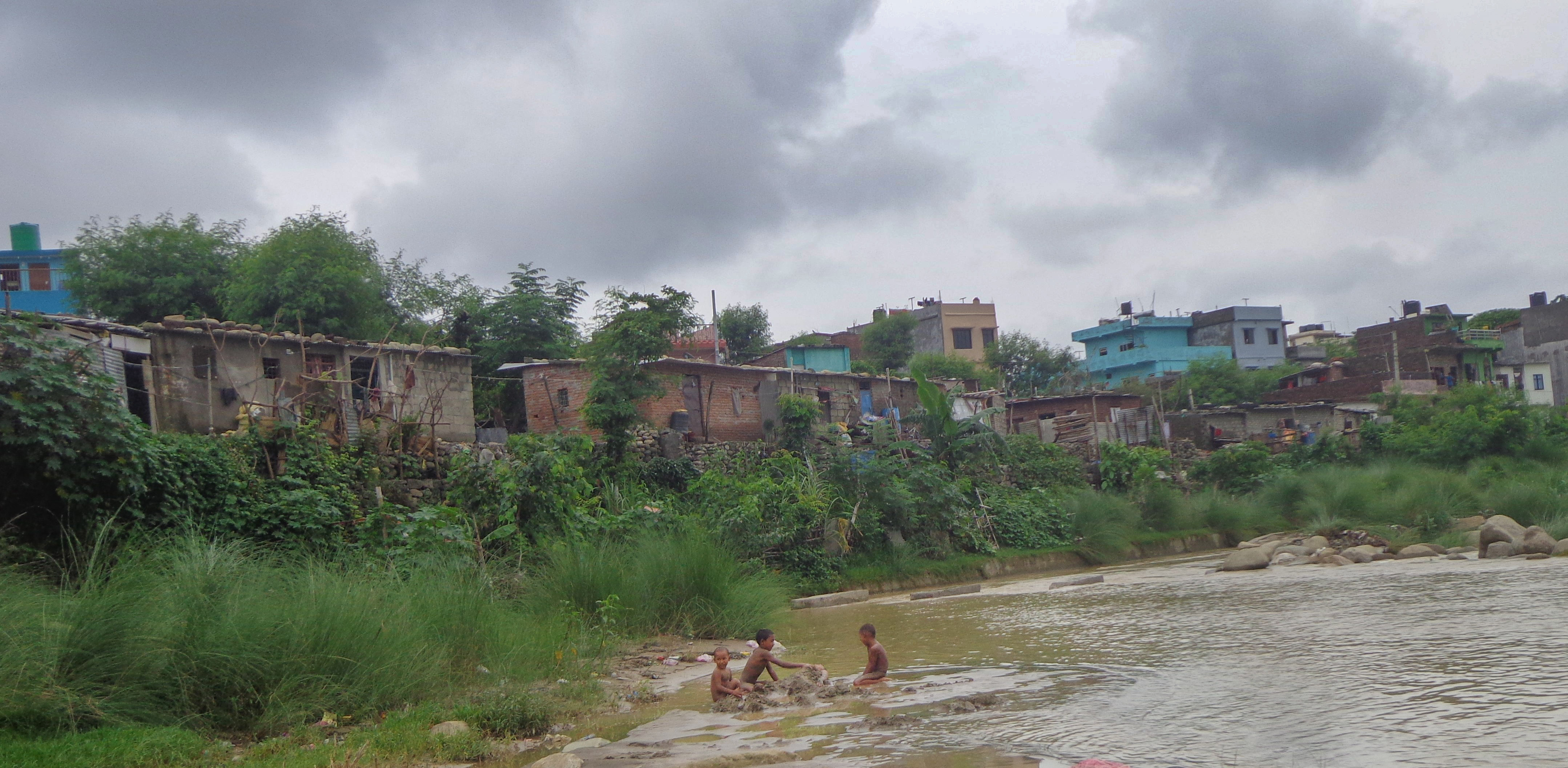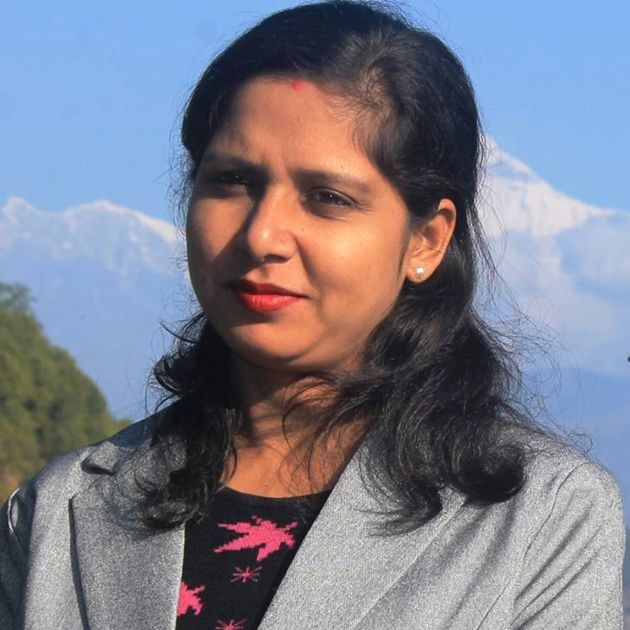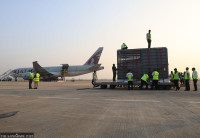National
Once a blessing for the region, the Tinau is gradually turning into a curse
Over a dozen settlements have sprung up on the banks and the course of the river, but the Butwal government, instead of cracking down, is providing them with amenities.
Amrita Anmol
The settlement had been established along the old course of the river, which it had abandoned. The Tinau’s water density lessens significantly during the winter and autumn but suddenly increases during the monsoon. The settlement is established every winter, when the river’s flow is weak.
“We don’t have any land we can call our own,” said Raju Nepali, one of the residents who returned to Kadaghari. “It’s not that we want to come back to the flooded area. We are compelled to move back and forth unless the government provides us with a viable alternative.”
For those with no land of their own, the river’s banks, which are public land, can be settled without paying any rent. This is why the banks and abandoned courses of the river are filled with squatter communities.
Like Kadaghari, over a dozen other places in and along the river—Buddhanagar, Top Majuwa, and Sundarnagar with the highest density—are currently occupied by squatter communities. According to the Butwal Submetropolis, over 4,000 people are currently living as squatters in and along the Tinau. Only this year, 250 more makeshift structures were added to the settlement’s one single ward.
Butwal, however, has been aiding the settlements. Instead of finding a long-term solution, city officials have been supplying the settlement with electricity and water. So what started with a few homes on the banks of the river has over the years expanded to block the very course of the river. What was once a long, wide river flows like a canal—narrow and deep—today.
Water experts say that the Tinau needs a 237-metre-wide space if the river is to be contained into its usual course during the monsoon, when it gets flooded with water from the Chure range. But today, the river’s course is hardly 50 metres wide.
“This means that the settlements along the Tinau will get flooded, perennially,” said Khet Raj Dahal, a research engineer who has been studying the river. “The river has already been shrunk to such an extent that it has absolutely no other option than to engulf the settlements.”
The Tinau starts from Madi and Kachal in Palpa district. By the time it gets to Butwal, over 30 small tributaries mix into it. The river divides into two from Madhyabazaar, after it flows for three kilometres inside Butwal. Per second flow of water in the river is 4,000 cubic metres.
Over the years, there have been some efforts to prevent flooding. The People’s Embankment Programme, launched by the government in 2009, has already spent over Rs 15 million constructing embankment to prevent the Top Majuwa settlement from being swallowed by floods every year.
The programme has invested about Rs 550 million for river management in the last decade. According to data from the municipal office, local councils have invested an additional Rs 50 million. About 15 kilometres across the river, there are concrete walls and embankments. But despite all these efforts, the river has not stopped wreaking havoc.

“The only option is to relocate the squatter settlements,” said Yubaraj Kandel, an independent researcher and Professor of Environment Conservation at Kalika Campus. “To complain about the flood when you made the decision to build a house along a river’s course is categorically wrong. Unless the settlements are relocated, any amount of investment will not lead to a sustainable solution.”
Bharat Sapkota, an engineer who previously worked at the People’s Embankment Programme, said that the embankments were built as ordered by the sub-metropolitan office to prevent floods. “Embankments obviously shrink the river’s course, but we had no choice,” said Sapkota. At several places, the river has already destroyed the embankments.
The Tinau is a major source of construction material and irrigation for Rupandehi district. But in the past two decades, due to unregulated excavation and human encroachment, the Tinau has been deteriorating.
“The Tinau river could have become a blessing for Rupandehi,” said Rabindra Gopal Lakaul, chairperson of the Batauli Conservation Committee, “but instead, it has become a curse.”
In the past fiscal year, around 83,300 cubic metres of gravel and boulders were excavated from the river. This has led the river to flow deeper than usual. That’s why there has been no significant flooding in the past three years. But some officials complain that local level authorities and police have paid no attention to the illegal excavations.
“The flood from Chure is unpredictable and wild,” Sapkota said. “There may come a day when the river floods so badly that it will engulf not just the squatter community but the whole city of Butwal.”
Butwal Mayor Shivaraj Subedi said that his office has started surveying and collecting data of all illegal settlements. In the submetropolis, a total of 16,193 homes have been built on public land. Of those, about 50 percent have been built by encroaching on the Tinau or Danab, another river which divides from the Tinau.
Subedi said that the city will come up with a plan to solve the crisis once it completes the survey. “This is not the problem of just two or four households,” he said. “The city alone can’t solve this crisis. We will coordinate with the provincial government and will discuss possible solutions.”
Over the decades, the Tinau has flooded several times, killing hundreds of people in 1961, 1970, 1981, 1993, 2002 and 2008. The worst flood was in 1970, when over a hundred lives were lost, hundreds of homes swept away and thousands of hectares of arable land destroyed.
Lakaul said that there have been too many rash decisions concerning the Tinau and if they continue, there will be an unconscionable tragedy.
“Today, the Tinau has been robbed by the people,” he said. “There will come a day when the river will rob the people.”
***
What do you think?
Dear reader, we’d like to hear from you. We regularly publish letters to the editor on contemporary issues or direct responses to something the Post has recently published. Please send your letters to [email protected] with "Letter to the Editor" in the subject line. Please include your name, location, and a contact address so one of our editors can reach out to you.




 12.99°C Kathmandu
12.99°C Kathmandu










%20(1).jpg&w=300&height=200)



